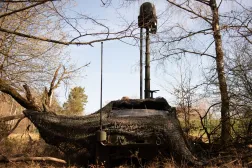Trump nominee for Joint Chiefs vice chairman vows to tackle electronic warfare challenges

Improving the U.S. military’s preparedness for electronic warfare will be a priority for Gen. Christopher Mahoney if he’s confirmed as the next vice chairman of the Joint Chiefs of Staff, he told lawmakers Thursday.
Mahoney, who has been serving as assistant commandant of the Marine Corps, was nominated by President Donald Trump in June to be America’s second-highest ranking military officer. The vice chair of the JCS plays a key role in the Defense Department as chair of the Joint Requirements Oversight Council and a senior adviser on technology-related initiatives.
The Defense Department in recent years has been trying to rebuild its electronic warfare prowess, which was allowed to atrophy after the end of the Cold War. Meanwhile, adversaries have been boosting their capabilities in the electromagnetic spectrum.
In his written responses to advance policy questions from lawmakers ahead of his confirmation hearing, Mahoney noted Russia’s improvements in its EW capabilities during its ongoing war with Ukraine — where it has been able to interfere with radar, drones and GPS — and China’s fielding of fixed and mobile EW systems that can interfere with satellite communication, spy satellites and GPS.
“Use of exploitation of and the ability to manipulate the EM spectrum is part of your warfighting function of fires, of intel, etc. And you have to be able to do that … from a training perspective in order to apply it, should we have to fight,” Mahoney said Thursday during his confirmation hearing with the Senate Armed Services Committee.
“If confirmed as the chairman of the JROC, this will be one of the key operational problems that we pursue, which is electronic warfare, more specifically, but electromagnetic spectrum — you can use the word ‘dominance’ or ‘exploitation.’ So in my position, should I be confirmed, this will be an operational problem that we will hit head-on,” he said.
Ensuring U.S. military systems are resilient to electromagnetic attack is critical for joint force lethality and survivability, Mahoney told lawmakers, noting the need for continued investment and innovation in this area.
The Pentagon must balance its spending on “exquisite capabilities” with the need to acquire systems that are inexpensive and can be produced at scale, he said, while also leveraging AI tools.
Mahoney also suggested enhancing training and education on electromagnetic spectrum operations, and working with other government entities to evolve laws and regulations on the use of the EMS operations inside and outside the U.S.
The Pentagon faces restrictions on when and where it conducts electronic warfare training domestically to minimize the risk of harm to civilian entities.
“The ability to conduct electromagnetic warfare testing, training, and experimentation in [the continental United States’] EW ranges is a challenge. Coordination with outside DOD agencies (FAA, FCC) needs to be fast, efficient, and flexible to allow the warfighter to train and operate at a level required for the future fight. Continued investment is necessary to ensure live ranges can exceed the requirements of today for the future environment,” Mahoney wrote.
Virtual training technologies could help overcome some of the current limitations, he suggested.
Mahoney noted that the Joint Staff is prioritizing the modernization of the “Joint Live, Virtual, Constructive simulation federation” in the coming years, with a focus on the EMS and space and cyber domains.
“Initial improvements are expected by FY26, with continued advancements through FY30, representing investment in preparing forces for the challenges of the electromagnetic spectrum. These efforts aim to ensure realistic and effective training in Joint Force Tier One exercises,” he told senators.
“We need to do more to provide the integrated, high-fidelity environment needed for developing next-generation joint EW concepts. If confirmed, I would support the Joint Force prioritizing aggressive improvements in this area to ensure readiness and maintain an edge in our ability to deter and defeat adversaries in the electromagnetic spectrum,” he added.
At Thursday’s hearing, Mahoney was asked about the importance of having joint multi-domain testing and training environments that blend kinetic and non-kinetic platforms and effects.
“We used to be pretty good at this — penetrate, exploit using the EM spectrum, whether it was EA-6Bs, whether it was F-111s. And we got out of the business for a long time, probably for the right reasons. But … training live, virtual, constructive, stitching together the ranges, having the ability to emit and receive and work out the systems, is critical,” he said.
Access to the spectrum itself is another concern. The commercial telecommunications industry has been pushing for access to the 3.1-3.45 GHz S-band that the U.S. military uses to operate important assets like radars, satellites, navigation systems and others that would be needed in future wars. Pentagon officials have estimated that moving those systems to other bands would cost hundreds of billions of dollars.
At Thursday’s hearing, Mahoney said the joint force has “extensive capabilities” that use that part of the spectrum, and that those platforms would be negatively impacted if the Defense Department had to vacate those bands or share them with commercial users in a non-optimized way.
Mahoney’s nomination is expected to be confirmed by the Senate. If approved, he will succeed Adm. Christopher Grady as vice chairman.






